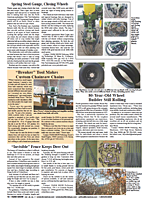2025 - Volume #49, Issue #4, Page #23
[ Sample Stories From This Issue | List of All Stories In This Issue | Print this story
| Read this issue]
Two-Wheel Electric Tractor Does It All
 |
 |
“The e2T eliminates about 80% of the dozen or more control levers on a diesel two-wheel tractor,” he says. “It also eliminates the vibration, and it doesn’t require the upper body strength needed to turn and control a two-wheel diesel.”
The e2T has a lot more than just remote control. While the basic unit is intended for draft purposes, the 10 receiver hitches in various locations offer a wide range of options. A third motor with a PTO shaft can slip into two receiver hitches for front or rear attachments. It provides instant power with full torque from zero to 1,200 rpm. Lift for attachments is supplied by electric actuators.
The receiver hitches can also be used to host a seat option in the rear, top or forward position. In the forward position, Heckeroth says it’s ideal for picking produce in the field with carriers for containers on either side.
Receiver hitches can also be used for a wide variety of attachments.
“The e2T can handle all the Tilmor tools, BCS attachments or pull trailers, compost spreaders and more,” says Heckeroth. “The receiver hitches can handle up to 1,000 lbs. They make it easy to use the e2T for everything from planting and transplanting to pulling implements and harvest, anything you can think of.”
He’s used it with a 60-in. sickle bar, mowing an acre in 2 1/2 hrs. He’s also tested it out with a reaper to cut and windrow.
Regenerative braking is active at three levels: simply reducing the speed, braking and machine action. If in use with a tiller, the tiller pulls/pushes the e2T through the field, and the wheel motors return power to the battery.
Throughout, Heckeroth has aimed for simplicity, versatility and economy. A graph on the company website compares it favorably with alternatives. The current 5 kWh battery configuration, with separate 3-hp motors on each wheel for draft operations, is priced at $7,500.
Options include dual wheels ($400), a 10-hp PTO compatible with walk-behind power implements ($1,900), seats ($300), a 550W PV shade canopy ($1,200), a 2000W inverter for mobile AC power ($1,200), and a 15 kWh LFP exchangeable battery ($2,400).
Heckeroth projects sales of 40 tractors this year and 500 in 2026. He expects to reach an output of 10,000 by 2030. While such growth is aggressive for a start-up, Heckeroth has a formidable history with electric tractors. He used a BCS two-wheeler on his homestead in the 1970s and became a BCS dealer. He repaired them for himself and others for about 20 years. During the same period, he was converting cars to electric and working with solar power. In 1992, the multiple interests merged.
At the time, he was building lightweight electric cars from kits. He realized tractors were ideal conversions, given the need for weight that batteries could supply.
He founded Electrac, custom-building 4-WD, battery-powered tractors, and consulted with a Japanese company in 1997 to design a tractor specifically for clearing landmines after wars. His prototypes utilized steer-by-wire technology, zero-radius turning, remote control operations, wheel motors, and onboard inverters/chargers for mobile AC power.
He also worked with the use of solar charging shade canopies and using implement-mounted motors to replace PTOs, improving safety and efficiency. The prototypes were also the first to use linear actuators on a full-function electric tractor. Many of these features are now integrated into the e2T.
In the early 2000s, he designed thin-film solar roofing products while continuing to experiment with electric tractor design. (Vol. 26, No. 4). In 2012, he founded Solectrac (Vol. 44, No. 2). After nearly 10 years of research, awards and growth, the company was acquired by a major investor.
He returned to his earlier focus on an electric two-wheel tractor.
“I built a prototype designed to be affordable,” says Heckeroth. “It had 20 in. of clearance, a wheel track of 40 in. and a motor on each wheel for zero radius steering.”
He found that handlebars tended to jump up and down enough that it was hard to control the throttle, so he opted for remote control.
“Remote control added $60 to the cost, but eliminating the handlebars cut the cost by $300,” says Heckeroth. “It made sense from affordability and function, and I could see what I was doing.”
It took Heckeroth about six months to perfect. He’s now in his final pre-production stage with four working prototypes. He does two or three on-farm demonstrations a week, looking for weak spots in the design.
“For the last six months, we’ve been testing the e2T in real-life conditions,” says Heckeroth. “Lately, it’s been working perfectly.”
He reports rave reviews from operators, especially women frustrated with the difficulty of handlebars, maintenance expenses and getting burned by the hot engine. He points to a host of testimonials on Renewable’s Instagram page.
“One told me that the e2T is her retirement package, ‘With the remote control, I can continue to farm into old age,’ she said,” reports Heckeroth.
Contact: FARM SHOW Followup, Steve Heckeroth, Renewables Inc., 3663 Regional Pkwy., Santa Rosa, Calif. 95403 (ph 707-235-8509; info@renewables.com; www.renewables.com).

Click here to download page story appeared in.

Click here to read entire issue
To read the rest of this story, download this issue below or click here to register with your account number.




